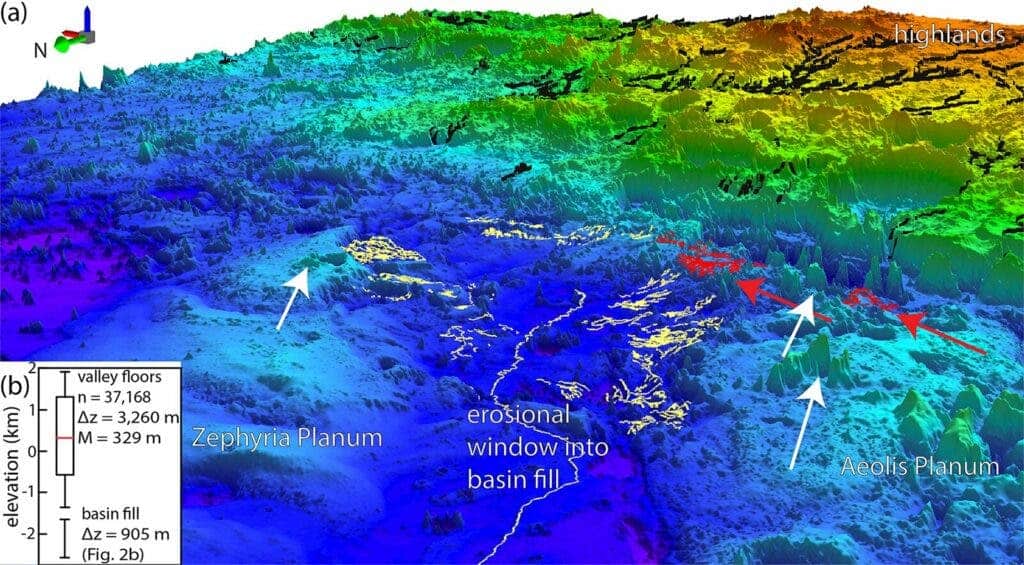We know that Mars once had bodies of water on its surface; it didn’t happen yesterday, in fact, it happened a few billions of years ago, but it did happen. But where and how much this water spread is still debated. For instance, it was never obvious whether the Red Planet had an ocean in its low-elevation northern hemisphere.
Now, using topography data and comparisons with Earth, researchers have been able to show definitive evidence that roughly 3.5 billion years ago, the area hosted an ocean that spread hundreds of thousands of kilometers and was at least 900 meters deep.

The good thing about studying Mars is that you’re not exactly starting from scratch: you already have another planet’s worth of data you can use — the Earth. For instance, we know the types of geological structures and textures that water creates with rocks here on Earth, so if we see the same type of thing on Mars, we can deduce that water was also present there.
Of course, it’s not as simple as that, but the guiding principle of looking for signs of ancient signs of water on Mars is pretty much that, looking for structures or rocks that we know were created by water. In this case, the researchers used software developed by the United States Geological Survey to map data from the National Aeronautics and Space Administration (NASA) and the Mars Orbiter Laser Altimeter. They discovered over 6,500 kilometers of fluvial ridges, and then grouped them into 20 systems, showing that the ridges are most likely remnants of ancient shorelines, like river deltas or submarine channel belts.
“What immediately comes to mind as one the most significant points here is that the existence of an ocean of this size means a higher potential for life,” said Benjamin Cardenas, assistant professor of geosciences at Penn State and lead author on the study recently published in the Journal of Geophysical Research: Planets.
“The rocks in Aeolis Dorsa capture some fascinating information about what the ocean was like,” he said. “It was dynamic. The sea level rose significantly. Rocks were being deposited along its basins at a fast rate. There was a lot of change happening here.”
These maps offer the strongest case for an ancient northern ocean on Mars. The researchers mapped ridge system locations, thicknesses, and elevations to understand the region’s paleogeography better than ever before. Basically, the area we now call Aeolis Dorsa was once a big ocean fed by a dense network of rivers. The results are also backed by a separate study that likened the landforms on Mars to those found beneath the Gulf of Mexico’s seafloor. Researchers created a model of Mars-like basin erosion, noting that what we’re seeing on Mars is clearly an indication of a large water system.
“The stratigraphy that we’re interpreting here is quite similar to stratigraphy on Earth,” Cardenas said. “Yes, it sounds like a big claim to say we’ve discovered records of large waterways on Mars, but in reality, this is relatively mundane stratigraphy. It’s textbook geology once you recognize it for what it is. The interesting part, of course, is it’s on Mars.”

Cardenas also added that this sedimentary record doesn’t only contain information about the water on Mars, but also about the climate. For instance, indicating that the planet experienced sea-level rise consistent with an extended warm and wet period.
“It also tells us about the ancient climate and its evolution. Based on these findings, we know there had to have been a period when it was warm enough and the atmosphere was thick enough to support this much liquid water at one time.”
So in addition to finding something about the Martian ancient history, we also have new clues for looking for signs of life. If life on Mars did exist (and the conditions are looking increasingly favorable for the emergence of life), and if any signs of it still exist, this ocean would be a very good place to start looking for it. In fact, Cardenas says some of the outcrops the Curiosity rover has been looking at are part of this river system.
“A major goal for the Mars Curiosity rover missions is to look for signs of life,” Cardenas said. “It’s always been looking for water, for traces of habitable life. This is the biggest one yet. It’s a giant body of water, fed by sediments coming from the highlands, presumably carrying nutrients. If there were tides on ancient Mars, they would have been here, gently bringing in and out water. This is exactly the type of place where ancient Martian life could have evolved.”
Journal References:
- Paleogeographic Reconstructions of an Ocean Margin on Mars Based on Deltaic Sedimentology at Aeolis Dorsa, JGR Planets;
- Martian landscapes of fluvial ridges carved from ancient sedimentary basin fill, Nature Geoscience.


